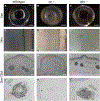Piebaldism and chromatophore development in reptiles are linked to the tfec gene
- PMID: 36702128
- PMCID: PMC10712277
- DOI: 10.1016/j.cub.2023.01.004
Piebaldism and chromatophore development in reptiles are linked to the tfec gene
Abstract
Reptiles display great diversity in color and pattern, yet much of what we know about vertebrate coloration comes from classic model species such as the mouse and zebrafish.1,2,3,4 Captive-bred ball pythons (Python regius) exhibit a remarkable degree of color and pattern variation. Despite the wide range of Mendelian color phenotypes available in the pet trade, ball pythons remain an overlooked species in pigmentation research. Here, we investigate the genetic basis of the recessive piebald phenotype, a pattern defect characterized by patches of unpigmented skin (leucoderma). We performed whole-genome sequencing and used a case-control approach to discover a nonsense mutation in the gene encoding the transcription factor tfec, implicating this gene in the leucodermic patches in ball pythons. We functionally validated tfec in a lizard model (Anolis sagrei) using the gene editing CRISPR/Cas9 system and TEM imaging of skin. Our findings show that reading frame mutations in tfec affect coloration and lead to a loss of iridophores in Anolis, indicating that tfec is required for chromatophore development. This study highlights the value of captive-bred ball pythons as a model species for accelerating discoveries on the genetic basis of vertebrate coloration.
Keywords: Mendelian phenotype; ball python; color morph; genomics; pigmentation.
Copyright © 2023 Elsevier Inc. All rights reserved.
Conflict of interest statement
Declaration of interests The authors declare no competing interests.
Figures




References
Publication types
MeSH terms
Substances
Grants and funding
LinkOut - more resources
Full Text Sources

